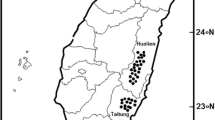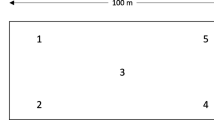Abstract
A pot culture experiment was carried out to investigate the accumulation properties of mercury (Hg) in rice grain and cabbage grown in seven soil types (Udic Ferrisols, Mollisol, Periudic Argosols, Latosol, Ustic Cambosols, Calcaric Regosols, and Stagnic Anthrosols) spiked with different concentrations of Hg (CK, 0.25, 0.50, 1.00, 2.00, and 4.00 mg/kg). The results of this study showed that Hg accumulation of plants was significantly affected by soil types. Hg concentration in both rice grain and cabbage increased with soil Hg concentrations, but this increase differed among the seven soils. The stepwise multiple regression analysis showed that pH, Mn(II), particle size distribution, and cation exchange capacity have a close relationship with Hg accumulation in plants, which suggested that physicochemical characteristics of soils can affect the Hg accumulation in rice grain and cabbage. Critical Hg concentrations in seven soils were identified for rice grain and cabbage based on the maximum safe level for daily intake of Hg, dietary habits of the population, and Hg accumulation in plants grown in different soil types. Soil Hg limits for rice grain in Udic Ferrisols, Mollisol, Periudic Argosols, Latosol, Ustic Cambosols, Calcaric Regosols, and Stagnic Anthrosols were 1.10, 2.00, 2.60, 2.78, 1.53, 0.63, and 2.17 mg/kg, respectively, and critical soil Hg levels for cabbage are 0.27, 1.35, 1.80, 1.70, 0.69, 1.68, and 2.60 mg/kg, respectively.
Similar content being viewed by others
References
Appel, C., Ma, L., 2002. Concentration, pH, and surface charge effects on cadmium and lead sorption in three tropical soils. J. Environ. Qual., 31(2):581–589. [doi:10.2134/jeq2002.0581]
Chaturvedi, R.K., Sankar, K., 2006. Laboratory Manual for the Physico-Chemical Analysis of Soil, Water and Plant. Wildlife Institute of India, Dehradun, India.
Chou, S., Huang, C., Huang, Y.H., 2001. Heterogeneous and homogeneous catalytic oxidation by supported γ-FeOOH in a fluidized-bed reactor: kinetic approach. Environ. Sci. Technol., 35(6):1247–1251. [doi:10.1021/es001129b]
Cunningham, S.D., Ow, D.W., 1996. Promises and prospects of phytoremediation. Plant Physiol., 110(3):715–719. [doi:10.1104/pp.110.3.715]
Daniels, B.G., Lindsay, R., Thornton, G., 2001. A review of quantitative structural determinations of adsorbates on metal oxide surfaces. Surf. Rev. Lett., 8(01n02):95–120. [doi:10.1142/S0218625X01000987]
Eto, K., Marumoto, M., Takeya, M., 2010. The pathology of methylmercury poisoning (Minamata disease). Neuropathology, 30(5):471–479. [doi:10.1111/j.1440-1789.2010.01119.x]
Fernández-Martínez, R., Loredo, J., Ordóñez, A., Rucandio, M.I., 2006. Physicochemical characterization and mercury speciation of particle-size soil fractions from an abandoned mining area in Mieres, Asturias (Spain). Environ. Pollut., 142(2):217–226. [doi:10.1016/j.envpol.2005.10.034]
GB 15618-1995. Environmental Quality Standard for Soils. Ministry of Environmental Protection of the People’s Republic of China (in Chinese).
Gee, G.W., Baunder, J.W., 1986. Particle-Size Analysis. In: Klute, A. (Ed.), Methods of Soil Analysis: Part 1-Physical and Mineralogical Methods. The American Society of Agronomy lnc., Soil Science Society of America lnc., Madison, p.383–411. [doi:10.2136/sssabookser5.1.2ed.c15]
Gnamuš, A., Byrne, A.R., Horvat, M., 2000. Mercury in the soil-plant-deer-predator food chain of a temperate forest in Slovenia. Environ. Sci. Technol., 34(16):3337–3345. [doi:10.1021/es991419w]
Gong, Z.T., Lei, W.J., Chen, Z.C., Gao, Y.X., Zeng, S.G., Zhang, G.L., Xiao, D.N., Li, S.G., 2007. Chinese soil taxonomy. Sci. Found. China, 15(1):41–45 (in Chinese).
Harada, M., 1995. Minamata disease: methylmercury poisoning in Japan caused by environmental pollution. CRC Crit. Rev. Toxicol., 25(1):1–24. [doi:10.3109/10408449509089885]
Hendershot, W.H., Duquette, M., 1986. A simple barium chloride method for determining cation exchange capacity and exchangeable cations. Soil Sci. Soc. Am. J., 50(3): 605–608. [doi:10.2136/sssaj1986.03615995005000030013x]
Huckabee, J.W., Sanz Diaz, F., Janzen, S.A., Solomon, J., 1983. Distribution of mercury in vegetation at Almadén, Spain. Environ. Pollut. Ser. A Ecol. Biol., 30(3):211–224. [doi:10.1016/0143-1471(83)90022-3]
John, M.K., 1972. Mercury uptake from soil by various plant species. Bull. Environ. Contam. Toxicol., 8(2):77–80. [doi:10.1007/BF01684509]
Khwaja, A.R., Bloom, P.R., Brezonik, P.L., 2006. Binding constants of divalent mercury (Hg2+) in soil humic acids and soil organic matter. Environ. Sci. Technol., 40(3): 844–849. [doi:10.1021/es051085c]
Kooner, Z.S., 1993. Comparative study of adsorption behavior of copper, lead, and zinc onto goethite in aqueous systems. Environ. Geol., 21(4):242–250. [doi:10.1007/BF00775914]
Li, Y., Chen, C., Li, B., Sun, J., Wang, J., Gao, Y., Zhao, Y., Chai, Z., 2006. Elimination efficiency of different reagents for the memory effect of mercury using ICP-MS. J. Anal. At. Spectrom., 21(1):94–96. [doi:10.1039/b511367a]
Loring, D.H., Rantala, R., 1992. Manual for the geochemical analyses of marine sediments and suspended particulate matter. Earth Sci. Rev., 32(4):235–283. [doi:10.1016/0012-8252(92)90001-A]
Mathur, S.P., Levesque, M.P., Desjardins, J.G., 1979. The relative immobility of fertilizer and native copper in an organic soil under field conditions. Water Air Soil Pollut., 11(2):207–215. [doi:10.1007/BF00286632]
McIntyre, S.H., Montgomery, D.B., Srinivasan, V., Weitz, B.A., 1983. Evaluating the statistical significance of models developed by stepwise regression. J. Marketing Res., 20(1):1–11. [doi:10.2307/3151406]
Morel, F.M.M., Kraepiel, A.M.L., Amyot, M., 1998. The chemical cycle and bioaccumulation of mercury. Ann. Rev. Ecol. Syst., 29(1):543–566. [doi:10.1146/annurev.ecolsys.29.1.543]
Munichandraiah, N., McGrath, K., Prakash, G.K., Aniszfeld, R., Olah, G.A., 2003. A potentiometric method of monitoring methanol crossover through polymer electrolyte membranes of direct methanol fuel cells. J. Power Sources, 117(1-2):98–101. [doi:10.1016/S0378-7753(03)00353-7]
Muñoz, O., Bastias, J.M., Araya, M., Morales, A., Orellana, C., Rebolledo, R., Velez, D., 2005. Estimation of the dietary intake of cadmium, lead, mercury, and arsenic by the population of Santiago (Chile) using a Total Diet Study. Food Chem. Toxicol., 43(11):1647–1655. [doi:10.1016/j.fct.2005.05.006]
OECD (Organisation for Economic Co-operation and Development), 1994. Mercury: Background and National Experience with Reducing Risk. OECD, Paris.
Onduru, D.D., Du Preez, C.C., 2007. Spatial and temporal aspects of agricultural sustainability in the semi-arid tropics: a case study in Mbeere district, Eastern Kenya. Trop. Sci., 47(3):134–148. [doi:10.1002/ts.207]
Rop, O., Valášek, P., Golian, J., Hoza, I., 2008. Dependence of uptake and distribution of mercury in vegetable plants on increasing content of mercury in soil. Sci. J. Phytotech. Zootech., 11(2):53–56.
Ryan, J., Estefan, G., Rashid, A., 2007. Soil and Plant Analysis Laboratory Manual. International Center for Agricultural Research in the Dry Areas, Aleppo, Syria.
Schnell, S., Ratering, S., Jansen, K.H., 1998. Simultaneous determination of iron (III), iron (II), and manganese (II) in environmental samples by ion chromatography. Environ. Sci. Technol., 32(10):1530–1537. [doi:10.1021/es970861g]
Shentu, J.L., He, Z.L., Yang, X.E., Li, T.Q., 2008. Accumulation properties of cadmium in a selected vegetable-rotation system of southeastern China. J. Agric. Food Chem., 56(15):6382–6388. [doi:10.1021/jf800882q]
Sims, J.T., 1986. Soil pH effects on the distribution and plant availability of manganese, copper, and zinc. Soil Sci. Soc. Am. J., 50(2):367–373. [doi:10.2136/sssaj1986.03615995005000020023x]
Spark, K.M., Johnson, B.B., Wells, J.D., 1995. Characterizing heavy-metal adsorption on oxides and oxyhydroxides. Eur. J. Soil Sci., 46(4):621–631. [doi:10.1111/j.1365-2389.1995.tb01358.x]
Wang, Q., Kim, D., Dionysiou, D.D., Sorial, G.A., Timberlake, D., 2004. Sources and remediation for mercury contamination in aquatic systems-a literature review. Environ. Pollut., 131(2):323–336. [doi:10.1016/j.envpol.2004.01.010]
WHO (World Health Organization), 2002. WHO Technical Report Series: Evaluation of Certain Food Additives and Contaminants. Fifty-Seventh Report of the Joint FAO/WHO Expert Committee on Food Additives. WHO, Geneva.
WHO (World Health Organization), 2004. Guidelines for Drinking-water Quality, 3rd Ed. WHO, Geneva.
WHO (World Health Organization), 2005. WHO Air Quality Guidelines Global Update. Report on a Working Group Meeting. Bonn, Germany, Oct. 18–20, 2005, WHO Regional Office for Europe.
Yadav, S.K., 2010. Heavy metals toxicity in plants: an overview on the role of glutathione and phytochelatins in heavy metal stress tolerance of plants. South Afr. J. Bot., 76(2):167–179. [doi:10.1016/j.sajb.2009.10.007]
Yin, Y., Allen, H.E., Li, Y., Huang, C.P., Sanders, P.F., 1996. Adsorption of mercury(II) by soil: effects of pH, chloride, and organic matter. J. Environ. Qual., 25(4):837–844. [doi:10.2134/jeq1996.00472425002500040027x]
Zhang, H., Feng, X., Larssen, T., Qiu, G., Vogt, R.D., 2010. In inland China, rice, rather than fish, is the major pathway for methylmercury exposure. Environ. Health Perspect., 118(9):1183. [doi:10.1289/ehp.1001915]
Author information
Authors and Affiliations
Corresponding authors
Additional information
Project supported by the Ministry of Environmental Protection of China (No. 2011467057) and the Fundamental Research Funds for the Central Universities of China
Rights and permissions
About this article
Cite this article
Liu, Cf., Wu, Cx., Rafiq, M.T. et al. Accumulation of mercury in rice grain and cabbage grown on representative Chinese soils. J. Zhejiang Univ. Sci. B 14, 1144–1151 (2013). https://doi.org/10.1631/jzus.B1300004
Received:
Accepted:
Published:
Issue Date:
DOI: https://doi.org/10.1631/jzus.B1300004




